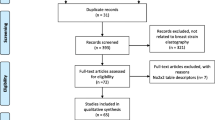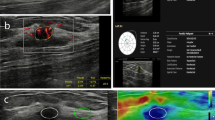Abstract
There has been controversy regarding the accuracy of breast ultrasound elastography (USE) compared to conventional B-mode Ultrasound (USB). The purpose of this study was to conduct a direct comparative effectiveness analysis of USB versus USE or their combination in differentiating breast lesions through systematically reviewing recent literature. An extensive literature search of PubMed and other medical and general purpose databases from inception through August 2011 was conducted. Published studies that reported a direct comparison of the diagnostic performance of USE, using elasticity score versus USB, using breast imaging reporting and data system (BIRADS) for characterization of focal breast lesions were included. Summary diagnostic performance measures were assessed for each of the tests and their combination using bivariate generalized linear mixed modeling. The two tests were combined as: (1) conjunctive, where the outcome of the combination of tests is positive only if both test results are positive; (2) disjunctive, where the outcome of a combination of tests is negative only if both tests are negative. Twenty nine studies provided relevant information on 5,511 breast masses (2,065 cancers, 3,446 benign lesions). Sensitivity of USB, USE, and their conjunctive and disjunctive combinations were 96% (95% credible interval (CrI), 93–98%), 79% (95% CrI, 74–83%), 73% (95% CrI, 67–78%), and 99% (95% CrI, 98–99%), respectively. Specificity of USB, USE, and their conjunctive and disjunctive combinations were 70% (95% CrI, 55–83%), 88% (95% CrI, 82–92%), 97% (95% CrI, 95–99%), and 56% (95% CrI, 43–69%), respectively. The application of USE as a single test is not superior to USB alone. However, in low risk patients it is recommended to perform an USE following a positive USB result to decrease the rate of unnecessary biopsies.







Similar content being viewed by others
Abbreviations
- AUC:
-
Area under curve
- USB:
-
B-mode ultrasound
- USE:
-
Breast ultrasound elastography
- BIRADS:
-
Breast imaging reporting and data system
- CrI:
-
Credible interval
- ES:
-
Elasticity score
- FN:
-
False negatives
- FP:
-
False positives
- I 2 :
-
Inconsistency index
- LR:
-
Likelihood ratios
- QUADAS:
-
Quality assessment of diagnostic accuracy studies
- SROC:
-
Summary receiver operating characteristic
- TN:
-
True negatives
- TP:
-
True positives
References
Garra BS (2007) Imaging and estimation of tissue elasticity by ultrasound. Ultrasound Q 23:255–268
Hatzung G, Grunwald S, Zygmunt M et al (2010) Sonoelastography in the Diagnosis of Malignant and Benign Breast Lesions: Initial Clinical Experiences. Ultraschall Med 31:596–603
Itoh A, Ueno E, Tohno E et al (2006) Breast disease: clinical application of US elastography for diagnosis. Radiology 239:341–350
Wells PN, Liang HD (2011) Medical ultrasound: imaging of soft tissue strain and elasticity. J R Soc Interface. [Epub ahead of print]
Regini E, Bagnera S, Tota D et al (2010) Role of sonoelastography in characterising breast nodules. Preliminary experience with 120 lesions. Radiol Med 115:551–562
Chang JM, Moon WK, Cho N, Kim SJ (2011) Breast mass evaluation: factors influencing the quality of US elastography. Radiology 259:59–64
Navarro B, Ubeda B, Vallespi M et al (2011) Role of elastography in the assessment of breast lesions: preliminary results. J Ultrasound Med 30:313–321
Lee JH, Kim SH, Kang BJ et al (2011) Role and clinical usefulness of elastography in small breast masses. Acad Radiol 18:74–80
Fischer T, Peisker U, Fiedor S et al. (2011) Significant Differentiation of Focal Breast Lesions: Raw Data-Based Calculation of Strain Ratio. Ultraschall Med. [Epub ahead of print]
Yerli H, Yilmaz T, Kaskati T, Gulay H (2011) Qualitative and semiquantitative evaluations of solid breast lesions by sonoelastography. J Ultrasound Med 30:179–186
Kumm TR, Szabunio MM (2010) Elastography for the characterization of breast lesions: initial clinical experience. Cancer Control 17:156–161
Thomas A, Degenhardt F, Farrokh A et al (2010) Significant differentiation of focal breast lesions: calculation of strain ratio in breast sonoelastography. Acad Radiol 17:558–563
Thomas A, Fischer T, Frey H et al (2006) Real-time elastography–an advanced method of ultrasound: First results in 108 patients with breast lesions. Ultrasound Obstet Gynecol 28:335–340
Thomas A, Kummel S, Fritzsche F et al (2006) Real-time sonoelastography performed in addition to B-mode ultrasound and mammography: improved differentiation of breast lesions? Acad Radiol 13:1496–1504
Thomas A, Warm M, Hoopmann M et al (2007) Tissue Doppler and strain imaging for evaluating tissue elasticity of breast lesions. Acad Radiol 14:522–529
Wojcinski S, Farrokh A, Weber S et al (2010) Multicenter Study of Ultrasound Real-Time Tissue Elastography in 779 Cases for the Assessment of Breast Lesions: Improved Diagnostic Performance by Combining the BI-RADS(R)-US Classification System with Sonoelastography. Ultraschall Med 31:484–491
Parajuly SS, Lan PY, Yan L et al (2010) Breast elastography: a hospital-based preliminary study in China. Asian Pac J Cancer Prev 11:809–814
Ciurea AI, Bolboaca SD, Ciortea CA et al (2011) The influence of technical factors on sonoelastographic assessment of solid breast nodules. Ultraschall Med 32(Suppl 1):S27–S34
Chung SY, Moon WK, Choi JW et al (2010) Differentiation of benign from malignant nonpalpable breast masses: a comparison of computer-assisted quantification and visual assessment of lesion stiffness with the use of sonographic elastography. Acta Radiol 51:9–14
Raza S, Odulate A, Ong EM et al (2010) Using real-time tissue elastography for breast lesion evaluation: our initial experience. J Ultrasound Med 29:551–563
Zhi H, Xiao XY, Yang HY et al (2010) Ultrasonic elastography in breast cancer diagnosis: strain ratio vs. 5-point scale. Acad Radiol 17:1227–1233
Sohn YM, Kim MJ, Kim EK et al (2009) Sonographic elastography combined with conventional sonography: how much is it helpful for diagnostic performance? J Ultrasound Med 28:413–420
Schaefer FK, Heer I, Schaefer PJ et al (2009) Breast ultrasound elastography—Results of 193 breast lesions in a prospective study with histopathologic correlation. Eur J Radiol 77:450–456
Zhu QL, Jiang YX, Liu JB et al (2008) Real-time ultrasound elastography: its potential role in assessment of breast lesions. Ultrasound Med Biol 34:1232–1238
Vanhoutte A, Fellah L, Galant C et al (2008) Contribution of sonoelastography to the characterization of breast lesions. JBR-BTR 91:187–194
Tan SM, Teh HS, Mancer JF, Poh WT (2008) Improving B mode ultrasound evaluation of breast lesions with real-time ultrasound elastography—a clinical approach. Breast 17:252–257
Zhi H, Ou B, Luo BM et al (2007) Comparison of ultrasound elastography, mammography, and sonography in the diagnosis of solid breast lesions. J Ultrasound Med 26:807–815
Scaperrotta G, Ferranti C, Costa C et al (2008) Role of sonoelastography in non-palpable breast lesions. Eur Radiol 18:2381–2389
Cho N, Moon WK, Park JS et al (2008) Nonpalpable breast masses: evaluation by US elastography. Korean J Radiol 9:111–118
Satake H, Nishio A, Ikeda M et al (2011) Predictive value for malignancy of suspicious breast masses of BI-RADS categories 4 and 5 using ultrasound elastography and MR diffusion-weighted imaging. AJR Am J Roentgenol 196:202–209
Tardivon A, El Khoury C, Thibault F et al (2007) Elastography of the breast: a prospective study of 122 lesions. J Radiol 88:657–662
Giuseppetti GM, Martegani A, Di Cioccio B, Baldassarre S (2005) Elastosonography in the diagnosis of the nodular breast lesions: preliminary report. Radiol Med 110:69–76
Kadour MJ, Adams R, English R et al (2010) Slip imaging: reducing ambiguity in breast lesion assessment. Ultrasound Med Biol 36:2027–2035
Bartolotta TV, Ienzi R, Cirino A et al (2011) Characterisation of indeterminate focal breast lesions on grey-scale ultrasound: role of ultrasound elastography. Radiol Med 116:1027–1038
Zhuang C, Xiao Y (2009) Ultrasonic elastography and molybdenum X-ray photography in differential diagnosis of breast diseases. Zhong Nan Da Xue Xue Bao Yi Xue Ban 34:67–71
Zhang XF, Liu XM, Bao XF et al (2006) Application of real-time tissue elastography in diagnosis of breast cancer. Zhejiang Da Xue Xue Bao Yi Xue Ban 35:444–447
Gong X, Xu Q, Xu Z et al (2011) Real-time elastography for the differentiation of benign and malignant breast lesions: a meta-analysis. Breast Cancer Res Treat 130:11–18
Sadigh G, Carlos RC, Neal CH, Dwamena BA (2011) Accuracy of ultrasound elastography for differentiation of malignant and benign breast abnormalities: a meta-analysis. Radiology (Accepted for publication)
Tohno E, Ueno E (2008) Current improvements in breast ultrasound, with a special focus on elastography. Breast Cancer 15:200–204
Yoon JH, Kim MH, Kim EK et al (2011) Interobserver variability of ultrasound elastography: how it affects the diagnosis of breast lesions. AJR Am J Roentgenol 196:730–736
Cochrane Diagnostic Test Accuracy Review Working Group. http://srdta.cochrane.org/handbook-dta-reviews. Accessed 15 Aug 2011
Ament A, Hasman A (1993) Optimal test strategy in the case of two tests and one disease. Int J Biomed Comput 33:179–197
American College of Radiology (2009) Breast imaging reporting and data system (BI-RADS®) ultrasound. http://www.acr.org/SecondaryMainMenuCategories/quality_safety/BIRADSAtlas.aspx. Accessed 12 Oct 2010
Whiting P, Rutjes AW, Reitsma JB et al (2003) The development of QUADAS: a tool for the quality assessment of studies of diagnostic accuracy included in systematic reviews. BMC Med Res Methodol 3:25
Chu H, Cole SR (2006) Bivariate meta-analysis of sensitivity and specificity with sparse data: a generalized linear mixed model approach. J Clin Epidemiol 59:1331–1332 (author reply 1332–1333)
Arends LR, Hamza TH, van Houwelingen JC et al (2008) Bivariate random effects meta-analysis of ROC curves. Med Decis Mak 28:621–638
Cronin P, Dwamena BA, Kelly AM et al (2008) Solitary pulmonary nodules and masses: a meta-analysis of the diagnostic utility of alternative imaging tests. Eur Radiol 18:1840–1856
Chappell FM, Raab GM, Wardlaw JM (2009) When are summary ROC curves appropriate for diagnostic meta-analyses? Stat Med 28:2653–2668
Deeks JJ, Macaskill P, Irwig L (2005) The performance of tests of publication bias and other sample size effects in systematic reviews of diagnostic test accuracy was assessed. J Clin Epidemiol 58:882–893
Higgins JP, Thompson SG, Deeks JJ, Altman DG (2003) Measuring inconsistency in meta-analyses. BMJ 327:557–560
Dwamena, BA (2007) MIDAS: Stata module for meta-analytical integration of diagnostic test accuracy studies. Statistical Software Components S456880. Boston College Department of Economics, Boston. http://ideas.repec.org/c/boc/bocode/s456880.html
Fleury Ede F, Fleury JC, Oliveira VM et al (2009) Proposal for the systematization of the elastographic study of mammary lesions through ultrasound scan. Rev Assoc Med Bras 55:192–196
Fleury Ede F, Fleury JC, Piato S, Roveda D Jr (2009) New elastographic classification of breast lesions during and after compression. Diagn Interv Radiol 15:96–103
Wang Z, Yang T, Wu Z et al (2010) Correlation between elastography score and strain rate ratio in breast small tumor. Zhong Nan Da Xue Xue Bao Yi Xue Ban 35:928–932
Jones CM, Athanasiou T (2009) Diagnostic accuracy meta-analysis: review of an important tool in radiological research and decision making. Br J Radiol 82:441–446
Metz CE (1978) Basic principles of ROC analysis. Semin Nucl Med 8:283–298
Moon HJ, Kim MJ, Kwak JY, Kim EK (2010) Probably benign breast lesions on ultrasonography: a retrospective review of ultrasonographic features and clinical factors affecting the BI-RADS categorization. Acta Radiol 51:375–382
Gutwein LG, Ang DN, Liu H et al (2011) Utilization of minimally invasive breast biopsy for the evaluation of suspicious breast lesions. Am J Surg 202:127–132
Bennett ML, Welman CJ, Celliers LM (2011) How reassuring is a normal breast ultrasound in assessment of a screen-detected mammographic abnormality? A review of interval cancers after assessment that included ultrasound evaluation. Clin Radiol 66:928–939
Conflict of interest
Ruth Carlos is a member of physician’s advisory board of Phillips. Gelareh Sadigh, Colleen Neal, and Ben Dwamena have no conflict of interest to declare.
Author information
Authors and Affiliations
Corresponding author
Electronic supplementary material
Below is the link to the electronic supplementary material.
Rights and permissions
About this article
Cite this article
Sadigh, G., Carlos, R.C., Neal, C.H. et al. Ultrasonographic differentiation of malignant from benign breast lesions: a meta-analytic comparison of elasticity and BIRADS scoring. Breast Cancer Res Treat 133, 23–35 (2012). https://doi.org/10.1007/s10549-011-1857-8
Received:
Accepted:
Published:
Issue Date:
DOI: https://doi.org/10.1007/s10549-011-1857-8




